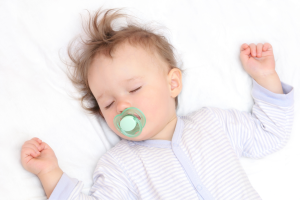Sleep apnea in toddlers
- Home
- Sleep apnea in toddlers
 What is sleep apnea?
What is sleep apnea?
Sleep apnea is a potentially serious disorder in which breathing is interrupted repeatedly during sleep.
There are three kinds of sleep apnea: obstructive sleep apnea (OSA), which is caused by a blockage; central sleep apnea, in which there is no blockage but the brain fails to signal the muscles to breathe; and mixed apnea, which is a combination of the two. OSA is the most common type of sleep apnea.
What causes obstructive sleep apnea?
OSA can be caused by anything that could physically block the airway and make it more difficult for your child to get enough air into his lungs. In children, enlarged tonsils or adenoids (the glands in the throat just behind the nose) are most often to blame. When your child’s muscles relax at night, these oversized glands can temporarily block air from getting to his lungs.
A child’s tonsils and adenoids may simply be a bit large naturally. In fact, sleep apnea is most common between the ages of 3 and 6, when tonsils and adenoids are at their largest compared with child-size airways. Tonsils and adenoids may also become enlarged from infection or allergies.
Other causes of airway blockages include being overweight and certain facial characteristics, such as a receding chin and a cleft palate. Children with Down syndrome and other congenital conditions that affect the upper airway have a higher incidence of sleep apnea. Over half of children with Down syndrome will develop obstructive sleep apnea.
How can I tell if my toddler has sleep apnea?
The list of symptoms for OSA is long. The most telling signs are snoring and difficulty breathing while asleep, often characterized by pauses in breathing. (In a sleep lab, a pause is ten seconds or more without breathing.)
Don’t jump to the conclusion that your child has sleep apnea if he snores, though; 1 to 3 percent of children have sleep apnea, while 7 to 12 percent of children snore, according to Gary E. Freed, D.O., a professor of pediatrics and director of the Pediatric Sleep Laboratory at Emory University School of Medicine in Atlanta. Likewise, it’s possible to have sleep apnea without snoring.
You should be suspicious if your child breathes through his mouth most of the time (both at night and during the day), often coughs or chokes at night, is a restless sleeper, or sweats profusely when he’s asleep.
Combined with any of the above symptoms, repeated night-wakings can be a sign of sleep apnea. Because children with sleep apnea have trouble breathing, they may stir more often, waking up to get the air they need.
If you think your toddler might have sleep apnea, look to his daytime behavior for more clues. Children with apnea are often sleep deprived, making them more prone to irritability, crankiness, and frustration. Your child may fall asleep at inappropriate times because he’s so tired.
A child with sleep apnea is also more likely to have tonsil- or adenoid-related health problems. Your child may be growing more slowly than he should if he’s not sleeping long enough to benefit from the growth hormones that are released at night. He may also not be growing properly if he works so hard to breathe at night that he’s burning up his calories. “It’s like running a marathon every night,” explains Freed.
What are the dangers of sleep apnea?
Most children with sleep apnea have mild symptoms that they simply outgrow. But sleep apnea can result in problems with growth, learning, and behavior. In severe instances, it can cause heart and lung problems and high blood pressure.
What should I do if I think my toddler might have sleep apnea?
Start by telling his doctor about it. She’ll ask you about your child’s sleep habits and examine his upper airway.
If she thinks that your toddler’s weight or allergies may be causing the problem, she may suggest dealing with those conditions first. She may refer you to an otolaryngologist (an ear, nose, and throat specialist), a pulmonologist (a lung specialist), a sleep expert, or an apnea expert.
The test that’s usually used to diagnose sleep apnea is called a polysomnogram. It monitors brain waves, eye movement, breathing, and oxygen levels in the blood, as well as snoring and gasping sounds during sleep.
One type of polysomnography is done in a sleep lab under standardized conditions and with continuous observation by trained sleep specialists. The other is a portable study that can be done at home, but it isn’t typically as accurate as the sleep lab study. Both are painless.
How is sleep apnea treated?
In 90 percent of cases, removing the tonsils and/or adenoids takes care of sleep apnea in children. Some children with obstructive sleep apnea need to use a CPAP (continuous positive airway pressure) machine, which keeps the airway open by blowing air into the nose via a mask during sleep. (A CPAP doesn’t usually relieve the symptoms of central apnea.)
Source: Babycenter.com
